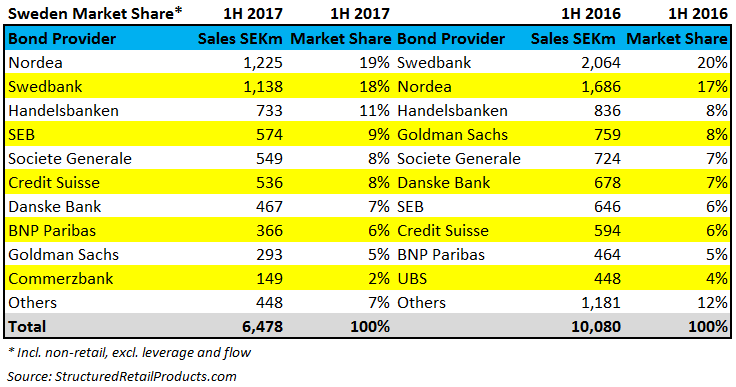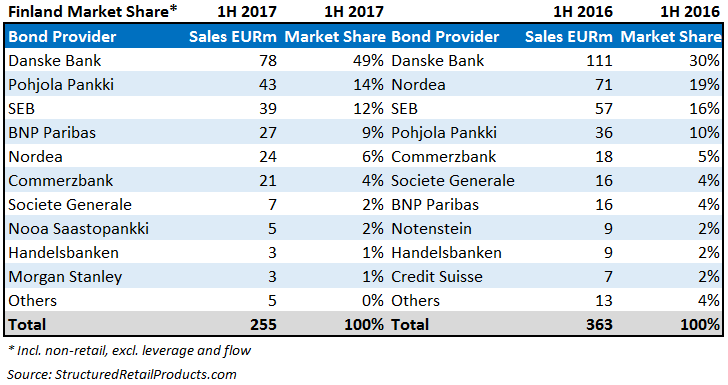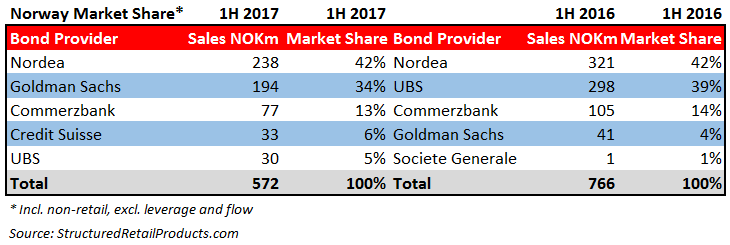Sales and issuance of structured products in the Nordics have failed to make a recovery in the first six months of 2017 compared to the same period in 2016, according to SRP data. With the exception of Denmark, were volumes increased by 40%, sales in Sweden, Finland and Norway decreased by 36%, 30% and 25%, respectively. Denmark, with a 20% increase, also bucked the trend when it came to issuance which was down in the other three markets, with Finland, where the number of new products during the semester was 40% down on the first half of 2016, and Sweden (down 27%), hit the hardest.
SRP reviews the data and the financial results of the top five structured products manufacturers in the Nordics.

Nordea was the only manufacturer of structured products active in all four Nordic markets during the first six months of 2017, according to SRP data. Nordea topped the table in Sweden, Denmark and Norway, with a market share of 19%, 44% and 42%, respectively, while in Finland the bank came fifth with a 6% share of the market. Sales volumes, however, were down across all markets. In Sweden the bank issued 34 structured products worth a combined SEK1.2bn (€124m) during the first half of 2017, down from 38 products with a sales volume of SEK1.6bn in the same period last year. In Finland Nordea collected €24m from eight products (1H 2016: 22 products/€71m) while in Denmark sales, at DKK812m (€109m) - from nine products - were up on last year (1H 2016: nine products/DKK759m). In Norway, nine products worth NOK238m (€25m) were sold during the semester (1H 2016: 11 products/NOK321m).
Nordea issued approximately €4.2bn in long-term funding in the second quarter of 2017, excluding Danish covered bonds and subordinated notes, of which approximately €0.9bn represented the issuance of Finnish, Swedish and Norwegian covered bonds in domestic and international markets.
Notable benchmark transactions in the quarter included, according to the bank, US$1.75bn (€1.5m) dual tranche senior unsecured issuance in May in the form of a $1bn three-year fixed and a $750m three-year floating rate note (FRN), a SEK4bn dual tranche senior unsecured issuance in June in the form of a SEK3.3bn three-year fixed and a SEK750m three-year FRN bond and finally in June a senior unsecured issuance in the form of a €500m five-year fixed rate green bond. The green bond was the first transaction of its kind from Nordea and was sold primarily to dedicated green bond investors.
Swedbank's structured products activity was restricted to Sweden where the bank was the number two provider, behind Nordea, with a share of 18% of the market in the first half-year of 2017. The bank sold 66 products worth SEK1.1bn between January 1 and June 30, 2017, down from 77 products with combined sales of SEK2.1bn during the same period last year. The majority of Swedbank's products in the semester were linked to equities (61), including 33 products linked to a share basket; 22 were linked to a single index; and six to an index basket. The remaining products were linked to foreign exchange rates (three) and credit (two), respectively.
As at June 30, 2017, Swedbank had SEK923.8bn debt securities outstanding, including SEK15bn worth of structured retail bonds.
'Our profit for the second quarter was strong,' said Birgitte Bonnesen (pictured), president and CEO, Swedbank, in a statement. Net interest income rose thanks to continued growth of the mortgage portfolio while increased customer activity in cards and payments and an upswing in equity prices improved net commission income, according to Bonnesen. 'We were pleased to see the great interest from customers in our new equity fund, Swedbank Robur Microcap, which we launched in the quarter. The fund, which focuses on innovative Nordic start-ups, has already attracted nearly SEK800m,' said Bonnesen.

Handelsbanken was active in Sweden, Finland and Denmark during the first semester. In Sweden, the bank issued 40 products worth SEK733m, which translated in a 11% share of the market (against 32 products and SEK836m in the first semester of 2016). In Finland, year-on-year sales were also down, with €3m collected from four products (compared to four products and €9m in the first semester of last year) while in Denmark, the bank's sole product, JB Novo Nordisk 2020, which was distributed via Jyske Bank, sold DKK100m.
Handelsbanken reported net savings in Sweden in its mutual funds amounted to SEK10.8bn during the first six months of 2017, corresponding to a market share of 18.1%. Net savings in the bank's mutual funds elsewhere in the Nordic region showed strong growth, increasing to SEK4.4bn. Total net savings in the group's funds amounted to SEK15bn. The total fund volume, including exchange-traded funds, increased by 10% from the beginning of the year to SEK468bn (1H 2016: SEK425bn). Total assets under management in the group rose during the same period by 7% to SEK582bn (1H 2016: SEK542bn).
SEB was the fourth most active issuer in Sweden and the third most active in Finland during the first semester of 2017, although it refrained from issuing structured products in both Denmark and Norway. In Sweden, the bank issued 41 structured products worth SEK733m (compared to 59 products and SEK646m in the first semester of 2016), with the distributors including Erik Penser, Garantum, Länsförsäkringar Bank, Skandia and Strukturinvest. In Finland, SEB sold 19 products (€39m) via Alexandria, FIM Pankki, SP Kapitaali and UB Omaisuudenhoito, against 31 products and €57m in the first semester of 2016).
For the second quarter, the effect from structured products offered to the public was approximately SEK195m, compared to SEK575m in the first quarter and SEK70m in the second quarter of 2016. (1Q 2017: 575, 2Q 2016: 70) in equity related derivatives and a corresponding effect in debt related derivatives of minus SEK450m (1Q 2017: -SEK95m, 2Q 2016: SEK5m), according to the bank.

Danske Bank issued structured products in Finland, Sweden and Denmark in the first half of 2017. In Finland, the bank was the main provider of structured products in the first semester, acquiring a share of almost 50% of the market (€78m) from 32 products while in Sweden the bank achieved a 7% market share from the sale of 31 products (SEK467m) which were distributed via Erik Penser, Garantum and Strukturinvest (1H 2016: 33 products/SEK678m).
In its domestic market Denmark, Danske's sales volumes increased by almost 33% in 1H 2017. The bank sold eight structured products worth DKK384m in the first semester compared to just three products with combined sales of DKK289m during the same period in 2016.
During the first six months of 2017, the Danske Group redeemed DKK12bn and issued DKK5bn of subordinated debt accounted for as liabilities. This included an issuance, in March 2017, of CRR-compliant convertible additional tier 1 capital of $750m with discretionary interest payments. As the bonds mandatorily convert into a variable number of ordinary shares if a trigger event occurs, they are accounted for as liabilities, according to the bank.

Click the link to view the full half-year 2017 results for Danske Bank (interim report, fact-book), Handelsbanken (interim report), Nordea (interim report, fact-book, presentation), Swedbank (interim report, fact-book, presentation) and SEB (interim report, fact-book).
Related stories:
Denmark Market Review - Q2 2017
Danske Bank global head departs amid reorganisation
Structured products are moving out of an unruly adolescence into adulthood, Garantum